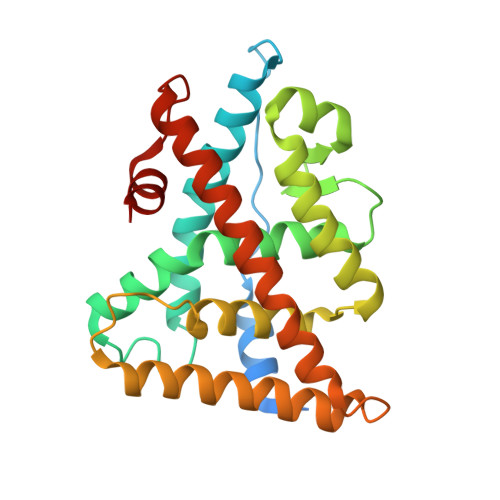Structural determination of estrogen-related receptor gamma in the presence of phenol derivative compounds.
Abad, M.C., Askari, H., O'Neill, J., Klinger, A.L., Milligan, C., Lewandowski, F., Springer, B., Spurlino, J., Rentzeperis, D.(2008) J Steroid Biochem Mol Biol 108: 44-54
- PubMed: 17964775
- DOI: https://doi.org/10.1016/j.jsbmb.2007.06.006
- Primary Citation of Related Structures:
2P7A, 2P7G, 2P7Z - PubMed Abstract:
We screened the ligand-binding domain of estrogen-related receptor (ERR) gamma in ThermoFluor, in an effort to develop chemical tools and decipher the biology of this orphan nuclear receptor. Several ligands were found to stabilize thermodynamically the protein. Amongst the ligands were bisphenol A (BPA) and 4-chloro-3-methyl phenol (ClCH3Ph). These ligands were further characterized and found to be competitive for 4-hydroxytamoxifen (4OHT) binding, a known reported antagonist ligand for ERRgamma, but functionally they did not enhance or disrupt affinity of the receptor for co-activator peptides. The preservation of the constitutive active conformation of the receptor in the presence of these two ligands was confirmed upon the determination of the co-crystal structures. The structures of BPA and ClCH3Ph were determined to a resolution of 2.1 and 2.3A, respectively, and the antagonist 4OHT was refined to 2.5A resolution. In the presence of BPA and ClCH3Ph the receptor maintained the transcriptional active conformation as reported previously for the apo-protein in the presence of a co-activator peptide fragment. In addition the ERRgamma-BPA structure identifies an interaction between the phenolic-OH and the side chain of N346. The preservation of the constitutive active conformation of the receptor in the presence of the small phenol compounds suggest that the biological activity of the receptor might be regulated by a natural occurring ligand.
Organizational Affiliation:
Johnson & Johnson Pharmaceuticals Research and Development, 665 Stockton Drive, Exton, PA 19341, USA. mabad@prdus.jnj.com



















